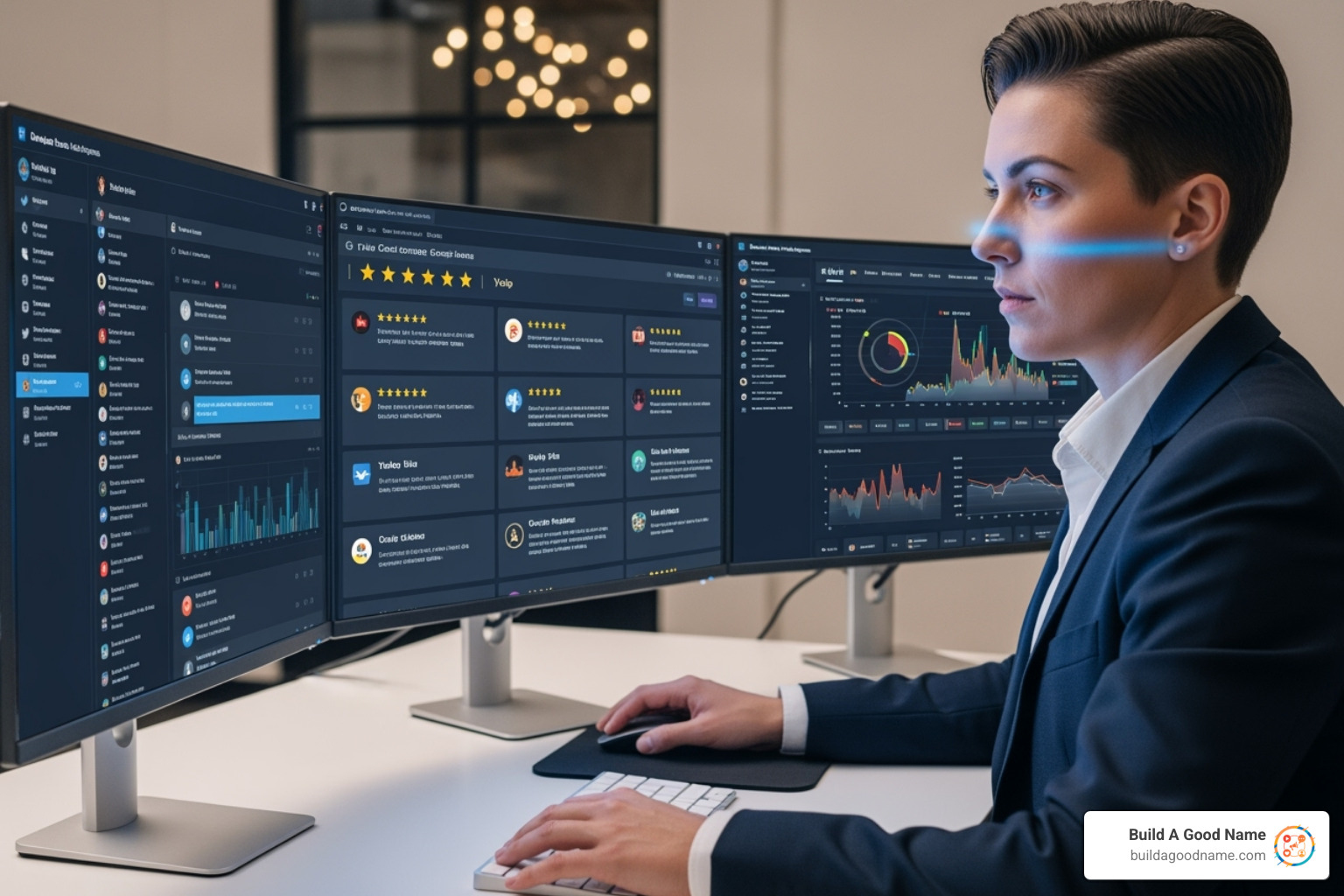Why Your Business Reputation Matters More Than Ever
Reputation management is the practice of monitoring, influencing, and maintaining how the public perceives your business or brand. It involves tracking online conversations, responding to customer feedback, and proactively building a positive image.
Key components of reputation management include:
- Monitoring – Track mentions, reviews, and social media conversations about your brand
- Building – Create positive content and encourage satisfied customers to share feedback
- Responding – Engage with both positive and negative customer reviews professionally
- Planning – Develop crisis response strategies and long-term reputation goals
- Measuring – Analyze metrics like star ratings, sentiment, and brand mentions
Your business reputation can make or break your success. Research shows that 86% of consumers say it’s essential that they purchase products from brands with a good reputation. This means every online mention directly impacts your bottom line.
The power has shifted to consumers, who now actively shape your brand’s story through reviews and social media. A single negative post can reach thousands in minutes, making every online interaction critical.
The good news is that active reputation management yields real results, including faster sales growth, higher customer trust, and better search engine rankings.
The key is proactivity. Successful businesses monitor their online presence, encourage positive reviews, and respond quickly to concerns instead of waiting for problems to arise.

Basic Reputation Management vocab:
The Foundational Pillars of an Effective Reputation Management Strategy

Effective reputation management requires three essential pillars working together: monitoring what people are saying, building positive content, and responding thoughtfully to customer feedback.
These pillars create a cycle: monitoring helps you understand what needs attention, building creates positive momentum, and responding shows customers you care. This approach turns your reputation into a competitive advantage.
CEOs rank reputation risk as a top concern because a strong reputation touches every part of your business, from marketing to customer experience. Let’s break down each pillar to build a working strategy.
Proactive Monitoring: Your First Line of Defense
Monitoring is about being informed—listening for opportunities and challenges before they become major issues.
Successful businesses track brand mentions across the web by setting up alerts for their business name, products, and services on news sites, blogs, forums, and social media.
Review scores directly impact your bottom line. Monitor individual reviews and spot trends to understand what customers are saying. Since 69% of consumers say reviews older than three months don’t count, so fresh feedback is essential.
Your search engine results tell a story about your business. When someone Googles your company name, what shows up? Positive reviews and high ratings often boost your local search rankings, while negative content can push potential customers away before they even contact you.
Social media listening gives you real-time insights into customer sentiment. It’s like having a focus group running 24/7. You can catch emerging trends, address concerns quickly, and even turn casual mentions into meaningful conversations with potential customers.
The key is tracking the right Key Performance Indicators (KPIs). Your average rating matters, but so does review volume growth, sentiment analysis, and your Net Promoter Score (NPS). These metrics paint a complete picture of how customers really feel about your business.
For businesses looking to streamline this process, our Reputation Management Tools can help automate much of the heavy lifting.
Building a Positive Online Presence
Building a positive presence means creating content and experiences that showcase your business at its best.
High-quality content positions you as an expert. Sharing valuable insights through blog posts or videos builds trust with people who want to work with businesses that know what they’re doing.
Social media engagement shows your personality. Join conversations, respond to comments, and show the human side of your business to build a community around your brand.
User-generated content is powerful because it comes from real customers. When customers share their experiences, it carries more weight than any ad. Smart businesses make it easy for customers to share and then amplify that content.
Thought leadership sets you apart from competitors. When you consistently share expertise and insights, you become the go-to resource in your industry. This builds long-term reputation value that’s hard to shake.
The most direct way to build positive presence is encouraging satisfied customers to share their experiences online. This is where we really help businesses shine. Our system makes it simple to Generate More Google Reviews by automating review requests and making the process seamless for customers.
Here are proven ways to encourage positive reviews:
- Ask customers directly after a great interaction, whether in-person, by email, or text message
- Provide clear, simple instructions for leaving reviews on your preferred platforms
- Set up automated review requests that trigger after positive experiences or purchases
- Feature your best reviews prominently on your website and social media channels
- Respond to all reviews to show you value customer feedback
- Offer non-monetary incentives like contest entries (always check platform guidelines first)
Responding to Customer Feedback: The Art of Engagement
How you respond to feedback—especially negative feedback—can define your reputation. It’s a public display of your character, and potential customers are watching.
Clear response guidelines ensure your team handles feedback consistently and professionally, maintaining your brand voice and values in every interaction.
Negative feedback is an opportunity. When you respond promptly, professionally, and empathetically, you show you care about customer satisfaction. Acknowledge the concern, apologize if needed, and offer a solution. Customers with resolved complaints often become loyal advocates.
Don’t forget positive feedback. Thanking customers for kind words shows appreciation, encourages others to share, and strengthens their loyalty to your business.
The magic happens when you successfully turn negatives into positives. A thoughtful response to a negative review sometimes impresses potential customers more than a dozen positive reviews. It proves you listen, you care, and you’re committed to making things right.
Timeliness matters more than perfection. Aim to respond to reviews within 48 hours. In today’s fast-moving digital world, a delayed response can feel like no response at all.
Unfortunately, fake reviews are a reality you’ll need to address. Learning to spot fraudulent reviews and knowing how to report them protects your genuine reputation from unfair attacks.
Our automated system helps businesses respond quickly and appropriately to all types of feedback. For detailed guidance on crafting effective responses, check out our Best Responses to Google Reviews resource.
Every response is a chance to show your values in action. Make it count.
Navigating Challenges: From Crisis Management to Ethical Conduct

Even the best reputation management plans face challenges. A viral complaint or ethical misstep can quickly damage your reputation. The key isn’t avoiding challenges, but being prepared for them.
This section is a crisis survival guide. We’ll cover preparing for emergencies, the role of employees, and the legal landscape. With the right preparation, challenges can strengthen your brand.
Preparing for and Managing a Reputation Crisis
When a reputation crisis hits, you don’t have time to figure things out. That’s why having a crisis response plan ready before you need it is essential. Think of it as insurance for your brand.
Early identification is your best friend. The sooner you spot a brewing problem, the more control you have. Monitoring tools become invaluable here, giving you precious time to respond before something goes viral.
When crisis strikes, stakeholder communication is critical. Your customers, employees, and the public are all watching. Clear, honest, and timely communication can mean the difference between a minor setback and a major disaster. Silence often makes things worse, as people fill information voids with negative assumptions.
Transparency and acknowledging mistakes are often your strongest tools. When United Airlines faced its infamous 2017 crisis, its market cap dropped $1.4 billion after a defensive initial response. Companies that quickly acknowledge problems and outline solutions often recover faster.
Post-crisis rebuilding is a marathon, not a sprint. You need to consistently demonstrate that you’ve learned from the experience and taken concrete steps to prevent similar issues. This means following through on promises and proving your commitment through actions.
The Role of Employees and Ethical Practices in Your Reputation
Your employees are walking representatives of your brand. They share their work experiences with friends, family, and on platforms like Glassdoor. Employees are your most powerful brand ambassadors—for better or worse.
When employees feel valued, they provide better customer service and speak positively about your company. Conversely, disgruntled employees can become your biggest reputation risk, as their criticisms can be particularly damaging.
Company culture is the foundation of your reputation. A strong, positive culture creates employees who are proud to work for you, and that pride shows in every customer interaction.
Corporate social responsibility is increasingly important to consumers, who want to support businesses that align with their values. This means being genuinely committed to ethical practices.
Honesty and brand values must be consistent. Consumers are savvy and can spot fake corporate responsibility. A 2015 study found that only 4% of consumers believed advertisers and marketers practiced integrity, showing how skeptical people have become.
The key is authenticity. Your values need to be lived, not just posted on your website. For a deeper understanding of these principles, check out this resource on Ethical Decision Making and Reputation Management in Public Relations.
Understanding the Legal Landscape of Reputation Management
The legal side of reputation management can be a minefield, but understanding the basics can save you from costly mistakes.
Defamation laws (libel for written, slander for spoken) protect against false, damaging statements. However, removing negative content from the internet is often difficult and expensive due to free speech protections. The focus is usually on mitigating impact.
Consumer protection laws require honesty in marketing and review practices. This includes being transparent about incentives for reviews and ensuring your claims can be backed by evidence.
Fake review policies are taken seriously by major platforms like Amazon, which has sued people for publishing fake reviews. The risks of getting caught far outweigh any short-term benefits.
Astroturfing—creating fake grassroots movements or reviews—is unethical and potentially illegal. It’s lying to your customers.
Data privacy regulations are becoming stricter. How you collect and use customer feedback data must comply with relevant laws. Being transparent about your data practices builds trust.
The bottom line? While removing negative content is difficult, focusing on ethical practices, legal compliance, and genuine customer relationships will serve you better in the long run.
The Future is Now: AI’s Transformative Impact on Reputation Management

Artificial intelligence is revolutionizing reputation management. Businesses no longer need to manually sift through reviews or delay responses. AI is changing how we monitor, analyze, and respond to public feedback.
AI works 24/7, analyzing every brand mention online. It’s like having a dedicated team member who can process thousands of reviews in minutes.
Sentiment analysis has become incredibly sophisticated. Modern AI understands context, sarcasm, and cultural nuances, helping you grasp how customers truly feel. For example, it can determine if “This place is something else” is a positive or negative comment based on context.
Real-time insights are a game-changer. The moment someone posts a review or mentions your business, AI systems can alert you with instant analysis. This speed is crucial in a digital world where a single negative post can spread like wildfire.
AI also predicts. Predictive analytics can spot patterns in customer feedback that humans might miss, like recurring complaints about service on Friday nights. This helps you prepare for challenges or capitalize on strengths.
The efficiency gains are remarkable. Companies using AI-powered platforms report dramatic improvements, such as a 510% increase in review volume while maintaining an 88% positive share, or a 148% increase in ROI by streamlining processes.
Our own AI-powered review management software takes automated responses to the next level. It generates personalized, human-sounding replies that consider the review’s content, the customer’s concerns, and your brand’s voice. This ensures every customer feels heard. You can learn more about this technology at Can AI Be Used to Respond to Online Customer Reviews?.
The beauty of AI in reputation management is that it improves human judgment, not replaces it. While AI handles data processing and initial responses, your team can focus on building deeper customer relationships and solving complex problems.
AI is no longer the future of reputation management—it’s the present. Businesses that adopt these technologies are already seeing the benefits of more efficient operations and stronger online reputations.
Leveraging Reputation for Growth and Competitive Advantage
Your reputation isn’t just about damage control—it’s a powerful growth engine. Investing in reputation management builds a foundation that drives real business results.
A company’s reputation can account for as much as 75% of its value. This metric can be the difference between thriving and surviving in a competitive market.
Customer loyalty becomes almost automatic when people trust your brand. Satisfied customers don’t just come back; they become advocates, increasing customer lifetime value and building sustainable growth.
The numbers tell a compelling story about how reputation influences purchasing decisions. As mentioned, 86% of consumers base their buying choices on a brand’s reputation. For example, Greystar generated 36 more leads and 10 more leases per location by focusing on reputation management, adding up to $108,000 in additional value.
Your online reputation also works as a search engine ranking booster. Google considers review signals—recency, quantity, and positivity—as major ranking factors. Managing your reputation well improves your SEO.
In a crowded marketplace, a stellar reputation gives you a competitive edge. It creates a “moat” that protects your market share. Stonegate Group demonstrated this by increasing their Rep Score 168 points above their industry average while maintaining a 4.5-star rating.
The connection between reputation and increased revenue is direct. Research shows a measurable revenue variance of 9% per reputation star. Moving from a 3-star to a 4-star rating can increase your revenue by nearly 10%.
A strong reputation also opens doors to valuable brand partnerships. Other reputable businesses want to associate with companies that have solid community standing, leading to new opportunities.
For a deeper understanding of how this builds lasting relationships with customers, explore How Reputation Management Builds Long-Term Business-Trust.
The bottom line? Reputation management isn’t a defensive strategy—it’s an investment in your future growth and success.
Frequently Asked Questions about Reputation Management
We get lots of questions about reputation management, which makes sense as the landscape is always evolving. Let’s tackle the most common questions we hear.
How is reputation management different from public relations (PR)?
These two are often mixed up but differ in scope and approach.
Public relations focuses on crafting and sharing your company’s message through media outreach and press releases to control the narrative.
Reputation management is broader, involving the ongoing process of monitoring, responding to feedback, and influencing public perception across all channels, especially online reviews and social media.
In short: PR is the story you tell; reputation management is managing the story others tell about you. The latter is more comprehensive, including customer experience, legal aspects, and direct feedback responses.
How long does it take to see results from reputation management efforts?
This is probably the question we hear most often, and the answer is: it depends.
Some results are immediate. When you respond thoughtfully to a negative review, that customer often feels heard and may even update their review. This can happen within days.
Building a strong foundation of positive reviews and improving search rankings is a long-term strategy that typically takes several months to show significant results. For example, we’ve seen restaurants improve their Google rating from 3.1 to 4.4 stars in about four months with consistent effort.
The key is understanding that reputation management is a continuous process of analysis, testing, and refinement. You’re not just fixing one problem—you’re building a system that improves your reputation over time.
Can you permanently delete negative content from the internet?
Here we need to set realistic expectations. Permanently deleting negative content from third-party sites like news outlets or review platforms is extremely difficult and often impossible.
The reason comes down to legal rights like freedom of speech. Most platforms protect legitimate customer feedback, even when it’s negative. Trying to remove content can be expensive and may not work.
Instead, effective reputation management focuses on suppressing negative content by promoting positive content and addressing feedback directly. This approach works better in the long run.
We help you create new, positive content that naturally pushes down negative search results. We optimize your web properties to rank higher and, most importantly, help you generate more authentic positive reviews.
This strategy is more effective, ethical, and sustainable than trying to hide from negative feedback.
Conclusion
Your business’s reputation management is the foundation of your success. When customer feedback is instant and widespread, your reputation shapes your future.
We’ve covered the essentials: Proactive monitoring keeps you aware, building a positive presence encourages good reviews, and thoughtful responses build lasting relationships.
What really matters is being prepared for the unexpected. Crisis planning and ethical practices are your safety net, while understanding the legal landscape helps you steer tricky situations.
Technology is making this easier than ever. AI tools can handle the heavy lifting of monitoring, analyzing sentiment, and even crafting personalized responses. Our AI-powered platform does exactly this, helping local businesses stay on top of reviews without drowning in day-to-day management.
The numbers don’t lie: a strong reputation drives real business results—more customers, higher loyalty, better search rankings, and increased revenue. It’s not just about looking good online; it’s about building a valuable asset that grows your business.
Your digital footprint tells your story whether you’re actively shaping it or not. The choice is to take control of that narrative or let others write it for you. Start building your reputation strategy today, because every day you wait is another day your competitors might be getting ahead.
Ready to take the next step? Dive deeper into Mastering Reputation Management in Business Today and find how to turn your online presence into your biggest competitive advantage.



